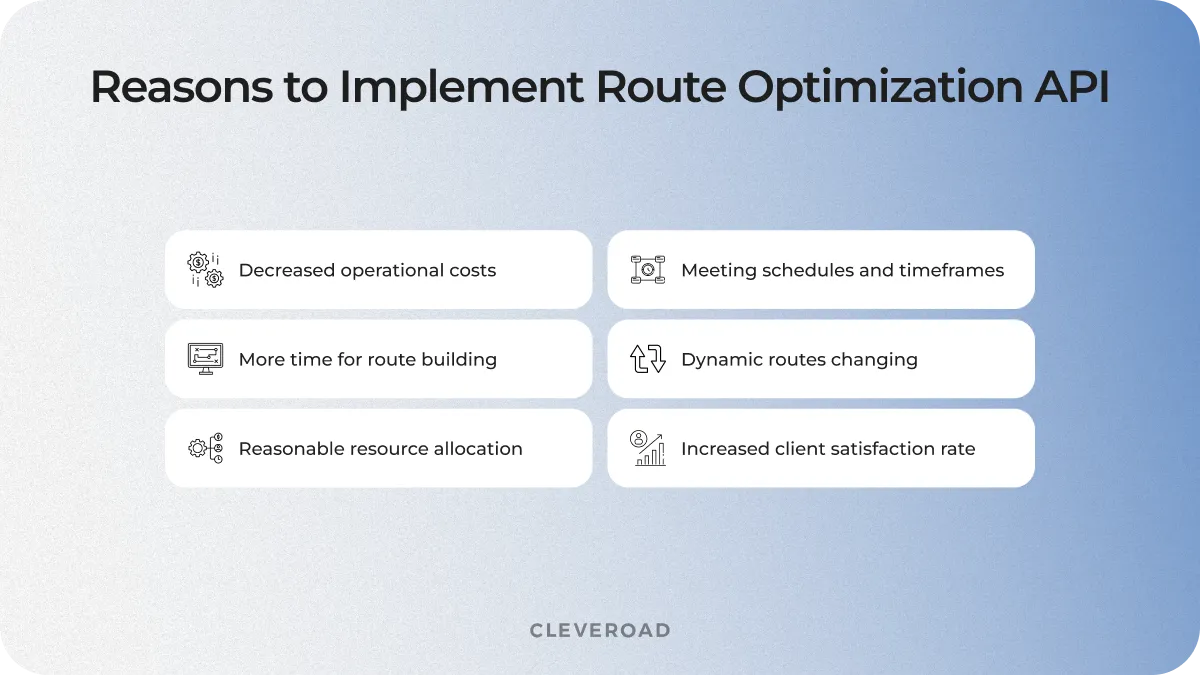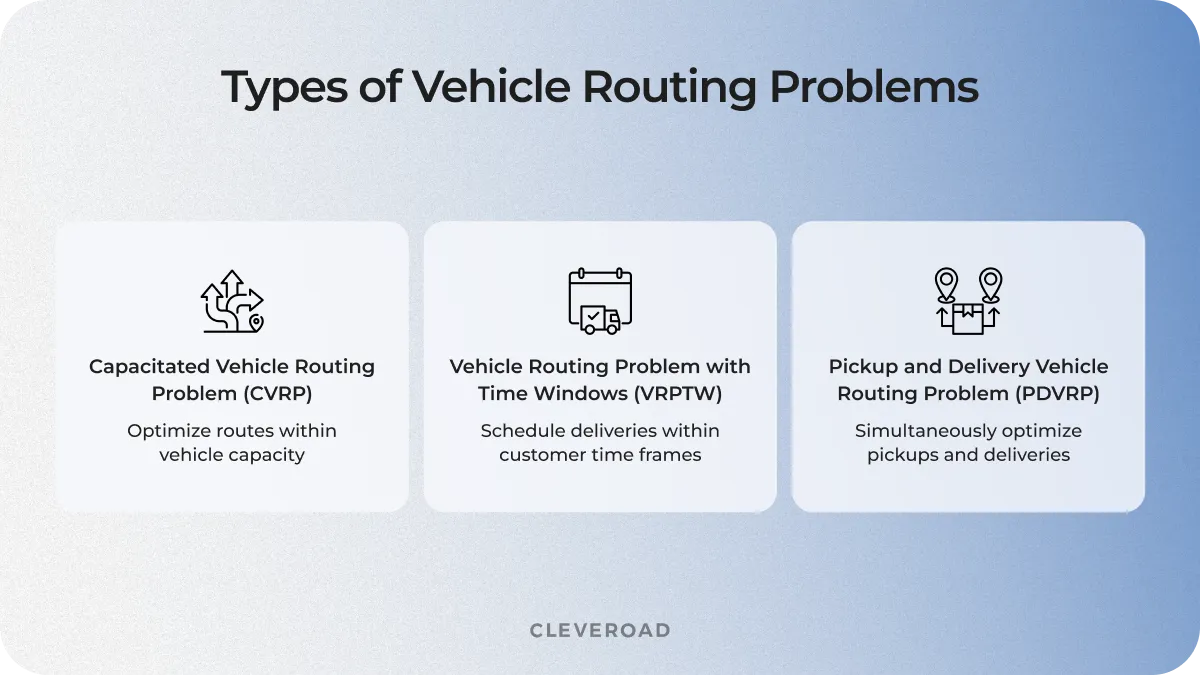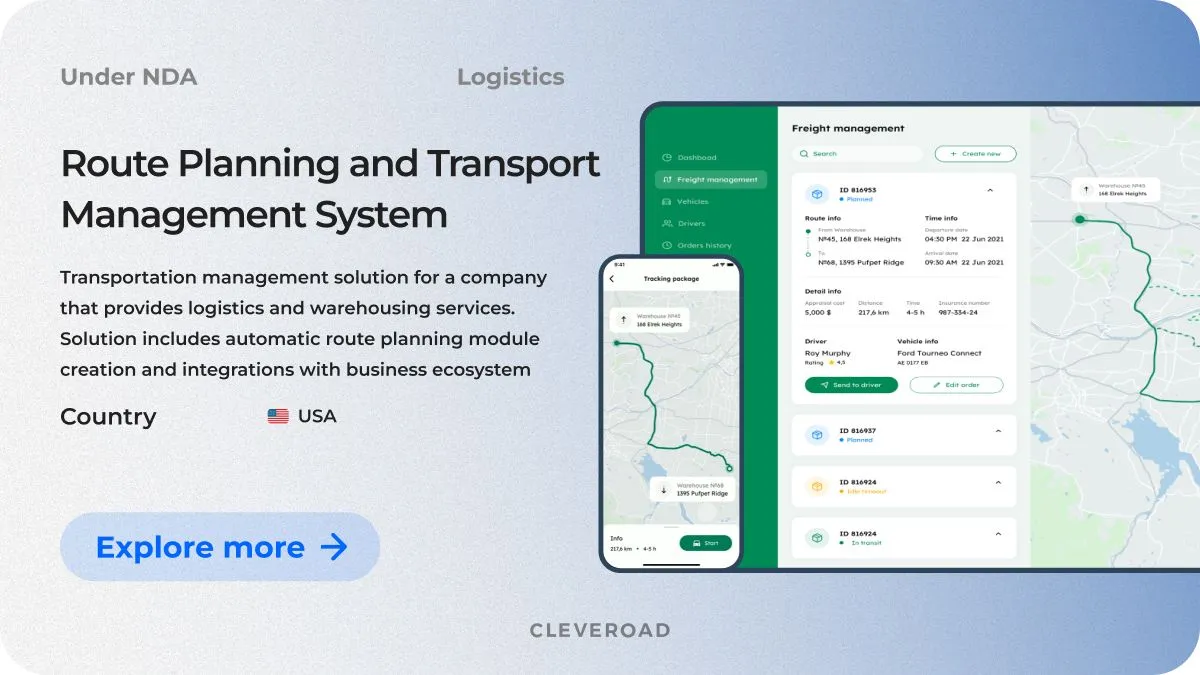Route Optimization API: What Is It, How It Works, and More
Updated 26 Sep 2024
17 Min
1536 Views
The route optimization API is a versatile solution for addressing modern businesses' logistics challenges. Whether managing multiple stops, optimizing delivery routes, or improving overall efficiency, this API is designed to adapt to your unique business needs. Companies across various industries are turning to route optimization APIs, reassured by its compatibility to streamline operations and cut costs.
In this article, you’ll discover how the API for route optimization helps overcome common logistics problems, the benefits it brings, and how you can seamlessly integrate the API to enhance your company’s workflows.
What is Route Optimization API and How Does It Work?
Routing optimization API is a software intermediary that enables logistics companies to streamline their delivery operations by calculating the most efficient routes. It integrates seamlessly with your existing systems to minimize fuel costs, reduce delivery times, and improve overall operational efficiency, making your logistics more agile and cost-effective.
This integration allows businesses like food delivery and field service to enhance their operations without the need to develop new software from scratch. The route optimization API uses powerful features such as real-time traffic updates and vehicle tracking, streamlining operations, and ensuring efficient, cost-effective route planning.
How does route optimization API work?
The operating algorithm of the route optimization API intelligently analyzes various critical factors, including road types, bridges, one-way streets, traffic patterns, and specific regulations. This data-driven approach ensures that the API generates the most efficient route possible.
Key considerations during the routing process include:
- Service timeframes: Ensuring deliveries meet deadlines
- Vehicle specifications: Factoring in type and capacity for optimal load management
- Stop management: Incorporating ferry locations and necessary stops along the route
- Carrier schedules: Aligning with overall logistics timelines
In practice, the routing optimization API continuously updates route suggestions in real-time based on live traffic data and changing conditions, allowing for quick adjustments. Additionally, it can integrate with existing logistics software, enabling seamless communication across systems and enhancing overall workflow efficiency. By leveraging these insights, a route optimization API helps businesses enhance operational efficiency and improve customer satisfaction.
Why use route optimization API
As businesses scale, the importance of incorporating a route optimization API becomes even more pronounced, enabling them to meet the demands of a growing customer base effectively. Let’s find out the major reasons why route optimization API is so important for your logistics-connected business.

Reasons to implement route optimisation API
Decreased operational costs. By optimizing routes, you can significantly lower operational expenses, including fuel and labor costs. It allows for better profit margins and resource reallocation.
Cut down time for route building. Such an API streamlines the route planning process, significantly reducing the time required to create optimal delivery paths. Due to this efficiency, your company can focus on other critical operational tasks.
Reasonable resource allocation. An API for route optimization enables you to allocate vehicles and fuel more efficiently, reducing waste and ensuring resources are used where they're needed most.
Meeting the set schedule and timeframe. With optimized routing, you can better adhere to the delivery schedules and time frames, boosting reliability in customer service. This reliability is crucial for maintaining competitive advantage in the market.
Creating routes according to dynamic conditions. The best route optimization API can adjust routes in real time based on changing conditions like traffic and weather, ensuring timely deliveries. It helps minimize delays enhancing overall delivery reliability.
Increased client satisfaction rate. Satisfied customers are more likely to become repeat clients and recommend the service to others. So, by ensuring timely and efficient deliveries, your business can enhance customer satisfaction levels.
To understand how route optimization APIs can effectively tackle these challenges, let's delve into the specific ways they address the vehicle routing problem.
How Route Optimization API Addresses the Vehicle Routing Problem
The Vehicle Routing Problem (VRP) presents a complex challenge of designing the most efficient routes for a fleet of vehicles traveling to multiple locations. Route optimization within the VRP involves determining the most cost-effective paths, which extends beyond simply finding the shortest distance. Factors such as travel time, effective loading strategies, and potential intersections must be carefully considered to achieve true optimization.
This problem is closely related to the Traveling Salesman Problem (TSP), which seeks the shortest possible route that visits a set of cities and returns to the starting point. As a result, the primary objective of vehicle route optimization is to create effective routes from a departure point to various destinations while adhering to specific business constraints. These constraints may include vehicle capacity, budget limitations, deadlines, and logistical requirements related to loading and unloading.
To tackle the VRP effectively, you can leverage route optimization APIs that incorporate advanced algorithms and real-time data, enabling them to navigate these complexities efficiently.
Let’s discover the main types of VRP to understand how the API for optimizing routes can help solve these problems.
Types of vehicle routing problems
Understanding the different types of vehicle routing problems (VRPs) is essential for businesses seeking to optimize their logistics operations. Each type presents unique challenges that require tailored strategies to enhance efficiency and reduce costs. Below are the main types of VRPs, highlighting their specific characteristics and considerations.

The major VRP types and their essential characteristics
Capacitated Vehicle Routing Problem (CVRP)
CVRP focuses on optimizing routes while adhering to the maximum load capacity of each vehicle. Companies must consider various challenges, such as multiple depots, a limited number of vehicles equipped for specific needs (e.g., refrigerated transport), and the varying weight and size of items.
The goal of overcoming such challenges is to minimize costs by maximizing cargo capacity per trip, ensuring efficient deliveries while staying within vehicle limits. Implementing CVRP solutions into transportation app development can significantly improve route efficiency and help businesses better manage their fleet resources.
A route optimization API can streamline CVRP by dynamically adjusting routes in real-time, considering vehicle load capacities and delivery constraints, allowing businesses to respond to changes like order volume or traffic conditions without overloading vehicles.
Vehicle Routing Problem with Time Windows (VRPTW)
In this scenario, deliveries must be scheduled within specific time frames set by customers. Failing to meet these windows can lead to reduced customer satisfaction and damage to the company’s reputation. Challenges include managing multiple, non-overlapping time frames, accommodating wait times between deliveries, and adhering to strict schedules that do not allow for delays. A delivery routing API can help optimize delivery routes and ensure timely delivery, minimizing the impact of these challenges.
Pickup and Delivery Vehicle Routing Problem (PDVRP)
This problem involves transporting cargo or passengers directly from one location to another without returning to a depot. It focuses on simultaneous pickups and deliveries, often reflecting real-time customer demands, such as taxi services or shuttle operations. The objective is to optimize routes for efficient service while meeting the specific needs of clients, resulting in consolidated delivery and pickup locations.
A route optimization API can solve PDVRP by dynamically adjusting routes in real-time based on evolving customer requests, ensuring timely pickups and deliveries while minimizing travel distance and fuel consumption.
Discover how to effectively solve vehicle routing problems with our logistics software development services!
The key benefits that the route optimization API delivers
The route optimization API offers a comprehensive solution for businesses beyond just solving routing problems. It helps streamline operations, improve efficiency, and enables significant gains in areas such as cost reduction, time optimization, and sustainability, making it an invaluable tool for companies looking to optimize their logistics and transportation processes.
We’ll discover other significant benefits of the route optimization API integration.
Fulfilling more daily orders. By optimizing routes and minimizing travel time, you can maximize the vehicle capacity and reduce idle time. This translates to increased productivity for your logistics company workflows and the ability to meet higher customer demand.
Improving driver satisfaction. By providing optimized routes, you can reduce the amount of time drivers spend on the road, minimize traffic congestion, and ensure that routes are planned to avoid stressful driving conditions.
Cutting down vehicle quantity for trip fulfillment. By using route optimization apps, your business can consolidate deliveries and reduce the need for multiple vehicles. This leads to substantial cost savings and enhanced operational efficiency.
Optimizing route planning time. The route optimization API automates the task of manual route planning, allowing you to quickly and efficiently generate optimized routes. This ensures that routes are always planned using the latest data and algorithms.
Limiting the carbon footprint of your fleet. By minimizing unnecessary mileage and optimizing routes, you can significantly reduce fuel consumption and associated emissions.
How to Use Routing Optimization API in Software Logistics Solutions?
According to the requirements of your business, it's significant to identify what route optimization algorithm to use specifically for your case. Below we'll reveal their classification and find out the solutions each option offers.
Algorithm for different numbers of stops
The approach to vehicle route optimization varies based on the number of stops involved. For a high number of stops (e.g., over 150), businesses like school bus services, newspaper distribution, and waste collection can benefit from a delivery routing API that minimizes the distance between points. This ensures efficient routes that cover many locations in the shortest possible time.
For a small number of stops (e.g., fewer than 150), the algorithm focuses on designing a streamlined route that doesn't necessarily prioritize proximity between stops. Instead, it ensures that all scheduled points are visited once within the designated time frame, offering flexibility in meeting delivery or service commitments.
Algorithm for route with a specific gap
In this case, the algorithm implies having a certain interval route when heading to the arrival spots. In practice, it may refer to the trip covering 50 stops. When passing 5 of them, the vehicle is projected to make changes in the route, like heading to the filling station or traveling to the store to have a bite to eat or purchase something else. This approach enhances efficiency through trip planning route optimization, ensuring that each stop is strategically managed for time and resources.
Algorithm for routes based on business needs
With the implementation of routing optimization SDK (Software Development Kit), you can tailor routes to meet specific operational requirements. Whether managing routes for deliveries, passenger transport, or service calls, the SDK allows for customization based on factors like the number of stops, vehicle capacity, and service windows. This customization ensures the algorithm fits the unique challenges of your business, whether dealing with a few stops or handling more complex logistics. This flexibility enhances resource utilization and streamlines workflows, aligning with your logistics needs.
Algorithm for adjusting routes in real-time
Real-time adjustments are crucial in dynamic environments where conditions like traffic, weather, or last-minute changes in delivery windows can impact schedules. Route optimization APIs provide real-time data, enabling your business to modify routes on the go for optimal performance. This ability to adapt to changing circumstances ensures that vehicles stay on schedule, improving service reliability and customer satisfaction. Real-time optimization can also help your company respond quickly to unexpected disruptions, maintaining operational efficiency.
To ensure you choose the most efficient routing optimization SDK for your software logistics solution, it's crucial to align the chosen algorithms with your specific business needs.
Consulting with qualified tech experts will help you identify the best-fit solution, whether you're managing complex logistics or fewer stops. You can contact us and we’ll also help you choose and implement an API that will fully adapts to the unique challenges of your business, providing long-term efficiency and scalability.
If you need all-in-one solution to solve the aforementioned tasks, you can build a route optimization software. Discover its peculiarities in our article!
How to Start Implementing Route Optimization Algorithm API in Business Management?
Here are the essential stages of the implementation process that will help you with the route optimization API integration. Please remember that the offered list below serves as an exemplary roadmap. Therefore, a more individual approach relevant specifically to your case can be ensured by a proficient tech services provider.
Assess business needs and requirements
Before integrating a route optimization solution, it's essential to thoroughly assess your business needs and identify the key challenges you want to address. Start by conducting an in-depth company analysis to uncover workflow inefficiencies and weak points that need improvement. You should consider factors such as your industry, the type of services you provide, and overall business objectives. A professional software provider can guide you through this process, eliminating the need to hire separate business analysts.
Once the analysis is complete, it's important to do the following:
- Set clear goals for the solution ensuring they align with your business objectives, such as reducing operational costs, improving delivery times, or enhancing customer satisfaction
- Define key performance indicators (KPIs) to measure its success and evaluate the effectiveness of the route optimization API
- Assemble a list of required features that align with your goals. This includes determining the appropriate algorithm for your case and planning the data flows, which are crucial for seamless integration between solutions
Select a skilled logistics IT vendor
The partner-selecting process is pretty complex. Due to this fact, we would like to turn your attention to the main tips to choose the right logistics IT provider and avoid pitfalls:
- Technical expertise: ensure the potential vendor possesses skills in software development services you require (e.g., finding the most suitable solution for integrating the route optimization API).
- Industry-specific knowledge: check if the vendor has familiarity with logistics-specific software development practices and necessities (such as route/load optimization, yard management, proof of delivery, etc.).
- Portfolio: track record of successfully delivering vendor’s projects in the field of logistics. You should check the portfolio on the vendor’s company website to discover that the vendor can develop the logistics solutions you need.
- Reputation and client feedback: Assess the reviews from the vendor’s past clients from popular hiring platforms like Clutch or GoodFirms. For example, Cleveroad’s Clutch page contains more than 60 reviews from our satisfied clients, including customer reviews, ratings, and project details.
- Confidentiality: ensure that they are willing to sign a non-disclosure agreement (NDA) to protect the originality of your route optimization platform concept.
Cleveroad stands out as a reliable logistics IT provider that meets the stringent requirements for technical expertise, industry-specific knowledge, and has a proven portfolio. Our commitment to confidentiality and positive reputation, as evidenced by client feedback.
Here's one of our client - John Salmon - review about their collaboration with Cleveroad on creating P2P ride sharing solution with route planning.


Choose and integrate the proper API
Once you’ve identified your business needs and chosen a logistics IT vendor, the next step is selecting the most appropriate route optimization API. The API you choose should be compatible with your current software infrastructure and flexible enough to handle your logistics operations.
Whether you're dealing with a small fleet or a complex network of delivery routes, the chosen API should have the capability to adjust to real-time conditions and scale with business growth. After selecting the API for route optimization, your vendor specialists can start the integration process to seamlessly incorporate it into your existing route optimization software.
Here are the TOP-5 route optimization APIs Cleveroad developers use when creating logistics solutions for routes improvement:
- Google Maps API. A widely-used API that offers real-time traffic data, route optimization, and geolocation services. It is ideal for businesses seeking accurate navigation, routing, and real-time updates across various industries.
- Mapbox Directions API. Known for its flexibility and customization options, Mapbox offers route optimization with detailed geospatial data, live traffic analysis, and multiple stop optimization. It's great for businesses needing custom maps and route adjustments.
- HERE Routing API. This API offers high-level route optimization with multi-stop routing, including predictive traffic, toll costs, and even environmental considerations like CO2 emissions. It's favored for its scalability and detailed geographic data.
- TomTom Routing API. TomTom provides advanced route optimization features with real-time traffic updates, smart route calculation, and multi-modal routing. It’s a strong option for logistics companies focused on accurate ETAs and real-time adjustments.
- GraphHopper Routing API. An open-source API that specializes in fast route optimization with customizable options for different transport modes and vehicle types. It’s suitable for companies that need flexible routing algorithms and quick integration.
Test and customize the route optimization algorithm
Before fully rolling out the API for optimizing routes, it’s important to thoroughly test the algorithm in various scenarios with the help of the vendor’s QA engineers. Based on these tests, you can further customize the algorithm to better suit your business’s unique routing needs, such as handling high-demand periods or accommodating specific vehicle restrictions.
For example, Cleveroad employs high quality management standards confirmed by the ISO 9001:2015 certification. It helps us ensure that the route optimization API is not only technically sound but also effectively addresses our specific logistical challenges, providing a seamless and efficient solution for our operations.
Customization ensures that the algorithm provides accurate, optimized routes under different conditions. It also helps you fine-tune factors like travel time and fuel consumption, ensuring the route optimization algorithm is fully adapted to your operations before full implementation.
Monitor performance and continuously improve API-integrated software
Even after the route optimization API is integrated and operational, continuous monitoring is key to maintaining its efficiency. Tracking performance metrics like delivery times, fuel usage, and route accuracy will help you identify areas for improvement. Regular evaluations of how the API is functioning allow for adjustments to the algorithm or system configurations, ensuring it continues to meet evolving business needs.
Working closely with your IT vendor during this phase can lead to further refinements, enhancing long-term performance. By focusing on continuous improvement, you ensure the API-integrated software remains a valuable asset to your business management strategy.
The development of routing optimization solutions within the logistics and transportation industries is always multi-component and involves a complex workflow. The implementation of such products and the subsequent business process optimization can only be realized in cooperation with a certified and experienced logistics software development vendor.
Cleveroad — Your Experienced IT Partner for Logistics Software Development
Cleveroad is a professional IT company with 12+ years of experience in the software development market. We also have the main office in Estonia and R&D centers in Estonia, Poland, Ukraine and the US. Our main specialization is building custom digital products architecture and delivery for businesses of all scales.
Logistics software development, as well as the supply chain domain, is one of Cleveroad's main development vectors. Therefore, our competence includes developing LMS, TMS, SCM, ERP, and a range of other digital solutions for supply chain optimization.
Collaboration with us offers a set of undeniable advantages, and some of them are:
- On-demand logistics software development including software modernization services, UI/UX design services, IT consulting services, DevOps services, cloud infrastructure services, and many more
- Synchronizing custom route optimization software with internal systems, external aggregators and carrier tools through APIs and EDIs
- Free Solution Workshop Stage to seamlessly link your logistics software concepts with its technology implementation
- Non-Disclosure Agreement (NDA) signing per your request to protect your route optimization platform idea’s uniqueness
- Robust Project Management office to control the workflows and deliver the desired outcomes timely and within the budget
- 280+ software development engineers allowing constant collaboration on your logistics project and eliminating the substitution needs, etc.
- Logistics software development with ISO 27001:2013 certified security management, assuring we provide advanced security measures that protect your systems and data, ensuring compliance and minimizing risks in sensitive logistics operations
Products architected by Cleveroad are aimed at decreasing operational costs, broader management capabilities, and wise resources distribution, supply chain optimization, and workflows of warehousing, transportation, and cargo delivery within the businesses of our clients. To prove our expertise, let us introduce some of our latest logistics products delivered connected to route optimization.
- Last-mile delivery service with real-time tracking. Our team has developed a mobile application for a leading parcel delivery company in France to provide their clients with management and monitoring parcel deliveries. The route optimization functionality enables efficient last-mile delivery planning, ensuring timely and accurate deliveries while minimizing costs.
- P2P solution for on-demand rides and delivery. Our logistics software development experts provided our US client with a transportation app connecting drivers with riders and helping transport the disabled people. Through the route optimization functionality, the app can recommend the most efficient routes for drivers, ensuring timely pickups and drop-offs while considering accessibility requirements for disabled passengers.
- Transportation management system with route planning. We’ve created a transportation management platform for our US client providing logistics and warehousing services. The platform also has a seamless route planner module that helps optimize delivery routes and enhance overall operational efficiency.
Integrate the route optimization API now
Our Logistics Solution Architect will help you choose necessary route optimization API according to your needs and the software development team will integrate it in your software
Route optimization refers to determining the most cost-effective path to a destination, which isn't just about finding the shortest route. It involves considering factors such as travel time, efficient loading, and road intersections. Utilizing tools like Google Maps or the Google Maps Platform, businesses can leverage a route planner API to make API requests that help identify the optimal route for their logistics needs.
A route optimization API is a tool that helps businesses calculate the most efficient routes by considering distance and time to streamline deliveries. It allows both synchronous and asynchronous communication, enabling real-time updates or batch processing of routing tasks. With provided SDKs, companies can easily integrate it into their systems to minimize the number of vehicles needed for operations. This results in optimized fleet management and reduced operational costs.
Route optimization is essential for efficient resource allocation, such as vehicles and fuel, helping to reduce operational costs. By utilizing a route planning API, companies can address optimization problems more effectively, minimizing issues like code problems and unnecessary thumb-downs from clients due to delays.
Additionally, it streamlines many steps in the planning process, ensuring routes adapt to dynamic conditions like traffic and weather, ultimately increasing client satisfaction and meeting scheduled timeframes.
The route optimization API offers several solutions to common logistical challenges. With comprehensive API documentation, developers can easily integrate the API into their systems, minimizing the risk of code issues that can lead to operational delays.
The API returns optimized routes that streamline dispatch processes, reducing fuel consumption and driver wages, while also addressing environmental concerns by lowering carbon emissions. Additionally, it alleviates the burden of constant client requests about cargo status by providing timely updates, helping to eliminate time-consuming route tracking.
To create a route optimization solution, start with business analysis to identify key use cases and requirements assembling. Next, consult with tech experts to select the right vendor and explore code samples that demonstrate effective route calculation. Utilize client libraries to implement the logic and ensure you can minimize the number of stops for efficiency. Additionally, consider integrating a free route optimization API to streamline the process.

Evgeniy Altynpara is a CTO and member of the Forbes Councils’ community of tech professionals. He is an expert in software development and technological entrepreneurship and has 10+years of experience in digital transformation consulting in Healthcare, FinTech, Supply Chain and Logistics
Give us your impressions about this article
Give us your impressions about this article
